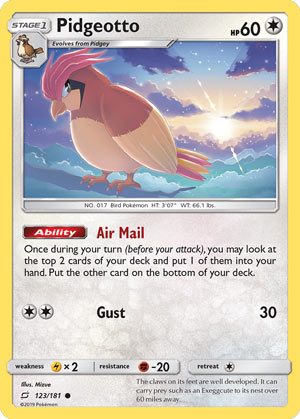
Pidgeotto
– Team Up
Date Reviewed:
January 6, 2020
Ratings Summary:
Standard: 4.00
Expanded: 3.50
Limited: 4.17
Theme: 4.00
Ratings are based on a 1 to 5 scale. 1 is horrible. 3 is average. 5 is great.
Reviews Below:
 Vince Pidgeotto has an ability which is almost similar to what Acro Bike does: look at the top 2 cards in your deck and the put one of them into your hand and the other in the bottom of your deck. Because of its 60 HP, it is searchable with Professor Elm’s Lecture as you can fetch both Pidgey and Pidgeotto from your deck onto your hand. Even though there are no shortcuts to evolving in the same turn you’ve played this Pokémon, Pidgeotto seems to be necessary in the Standard format at the moment, as there’s no other Pokémon that can do a similar thing Pidgeotto does. And it doesn’t get affected by most things that hinder GX Pokemon, so it’s ability is pretty much safe even though it’s HP is fragile. Ratings:
Conclusion: I might not have chimed in before, but I probably would have underrated this card like the others. As with some cards, it might take some time until it gets to shine, and Pidgeotto definitely made it at the right time. |
 Otaku We’re beginning this week with a re-review that is not a Throwback, as the card isn’t a full year old yet, Pidgeotto (SM – Team Up 123/181). We didn’t get around to reviewing it until April 12, 2019. If you read that, you’ll notice we didn’t score the card too high, which is the reason for the re-review. It took some time, but decks using Pidgeotto as a Bench-sitter eventually started doing well at major events, though I don’t recall it having happened until after that year’s set rotation, and that is something I said could happen. What I did not foresee was Pidgeotto making good in the Expanded Format as well. Pidgeotto didn’t make my Top 11 for 2019, let alone the site’s, but I starting to wish it had, as we owed it a second look… hence reviewing it today. Pidgeotto is almost all about its Ability, “Air Mail”. Once per turn, before you attack, Air Mail lets you look at the top two cards of your deck. You then get to add one of those cards to your hand, while the other goes to the bottom of your deck. Exactly how much better getting to pick one of two cards is better than just drawing one will depend on the deck, both in general and at that specific moment. It is also important that the card you do not select goes to the bottom of your deck. Bottom-decking it is the happy medium between having to shuffle something useless back into your deck or having to discard something useful. There are even a few combos to take advantage of knowing something is on the bottom of your deck. Pidgeotto is a [C] Type Pokémon, which means it is won’t ever attack into Weakness or Resistance. Most of the [C] Type counters and support are useless, but it looks like some Expanded decks utilizing Pidgeotto are including Winona… and doing well. Being a Stage 1 is important to Pidgeotto; while it would probably be better as a Basic, part of what makes it work in Expanded is not being a Basic, so it doesn’t have to worry about Silent Lab. 60 HP means it is fragile, but there is an upside to the situation: Professor Elm’s lecture can fetch it from your deck. [L] Weakness was very dangerous during most of this card’s 2019 run, and [F] Resistance often (but not always) handy, but the HP meant neither Weakness no Resistance was going to matter all that often. The Retreat Cost of [C] was nice and low, easy to pay or zero out. Its “Gust” attack was and is pure filler, dealing 30 damage or [CC]… but still better than nothing, or many worse attacks we’ve seen on such cards. Putting this all together, especially in a post-Zoroark-GX metagame, and we saw more and more decks trying Pidgeotto as reusable, sustainable draw power. It was fragile, but it wasn’t a Pokémon-GX so it didn’t run afoul Glaceon-GX, Great Catcher, Power Plant, etc. Sometimes, we saw Pidgeotto used to back a strong attacker, but it is famous for its use in control decks. That “selective draw” seems to be a perfect fit for control decks. The only way things might get better for Pidgetto is if we got a Pidgeot worth using it with, but that doesn’t mean this card is insanely good, either. It does what it needs to do, in a manner that makes it just right for the current metagame in both Standard and Expanded. Of course, it also is a valuable addition to almost any deck in the Limited Format and the Theme Format! Ratings
Part of me has a hard time believing PCL was aware that several of the obvious drawbacks of the card would (at worst) become balanced out by the nuances of the game post-rotation… as well as several of the threats in Expanded. It can’t be a coincidence, though, so kudos to them! |
 aroramage You ever take a look at a card and go, “Oh yeah, that card’s alright, it’s definitely not going to be part of one of the strongest control decks in the modern TCG, or heck even the strongest control deck in Standard,” and then find you might end up regretting it later because it ends up doing just that? Yeah welcome to a quick guide to Pidgeotto. Pidgeotto is a Stage 1 Colorless Pokemon, 60 HP, with a Lightning Weakness, a Fighting Resistance, and a Retreat Cost of 1. Gust is pretty much never used as a 2-for-30 vanilla strike, but Air Mail is the Ability that Pidgeotto lives and dies by…err, faints by. Basically you can pick up the top 2 cards of your deck and put one of them into your hand and the other on the bottom of your deck. That’s it, that’s the whole Ability. So how does something like Air Mail, which is itself a decent ability anyway, suddenly make it all the way up to the top spots in the meta? Time to educate ourselves on Pidgeotto Control! Or you might be more familiar with its older brother that Pidgeotto ends up helping out: Oranguru Control. Oranguru comes from the Ultra Prism set – yeah, remember that one? – where it became infamous for its Resource Management attack. And to fully understand the strategy of this, there’s one central idea that really comes in handy when playing around with Pidgeotto and Oranguru: stacking the deck. Did you ever watch the Cardfight Vanguard anime? I mean I wouldn’t blame you if you hadn’t – it’s been on the air for a while now, and that game has changed…dramatically from how it started out. But when I think of stacking the deck, I always think to this one fight one of the characters had where they would take the top few cards of their deck every turn or so with an effect, rearrange the order of those cards, and then put them back on the bottom. Because of their eidetic memory – or as we’d call it, “photographic memory” – they were able to memorize the order in which the cards were stacked, meaning that once they had drawn a specific amount of cards from the top of their deck, they got to a deck in which the order of their cards was precisely what they needed to win the game. In other words, using in-game mechanics, they literally stacked the deck in their favor! That’s what Oranguru Control is all about. You don’t have to have a photographic memory to know that cards like Chip-Chip Ice Axe and Crushing Hammer are great for disrupting the flow of your opponent’s strategy. Throw in hand disruption from cards like Reset Stamp, Jessie & James, and Mars, as well as deck destruction through Belleba & Brycen-Man, and there’s not a whole lot of actions your opponent can take. Of course there’s only so many copies of the cards you can use, and getting them out consistently – keyword there, consistently – can be difficult to execute. Well Oranguru lets you recycle any of the cards you use to the bottom of your deck, and Pidgeotto’s Air Mail lets you not only sift through your deck for what you want but can even stack your deck to get you the perfect draw late in the game to keep disrupting your opponent! Eventually you’ll just win out either by decking your opponent out or just wiping out their board with Articuno-GX, the only real attacker necessary for the deck! There’s also a lot of tech options you can toss around – Bronzong for Fire-proofing, Slowking for Lost Zone hand removal, Girafarig to send discarded cards to the Lost Zone, Faba for another Supporter with disruption, even running Will to get those coin flips off successfully – but no matter how you build the deck, Oranguru Control nowadays wouldn’t be possible without Pidgeotto’s help! Rating Standard: 4/5 (it’s apart of a powerfully solid deck in the current meta) Expanded: 3/5 (I feel like there are better options here for Pidgeotto’s role, as well as better control decks around and about) Limited: 4.5/5 (overall solid here in terms of draw power) Arora Notealus: You might wonder how good the Oranguru Control deck really is. Well to give you an idea, in San Diego, the deck placed as high up as 9th place, a real achievement in a tournament with hundreds of participants! Surprisingly, it got beaten out by another deck running Pidgeotto – Blacephalon! Using Air Mail to grab for Fire Crystals and Fiery Flint, the deck aimed more towards Blacephalon’s offensive Fireball Circus rather than the slower hold-up from Oranguru Control. This just shows that Pidgeotto isn’t just making one deck successful – it’s making a few other decks successful in their own right! Next Time: Take your ol’ rod out and fish by the school of Wishiwashi… |
We would love more volunteers to help us with our Card of the Day reviews. If you want to share your ideas on cards with other fans, feel free to drop us an email. We’d be happy to link back to your blog / YouTube Channel / etc. 😉
Click here to read our Pokémon Card of the Day Archive. We have reviewed more than 3500 Pokemon cards over the last 17+ years!



